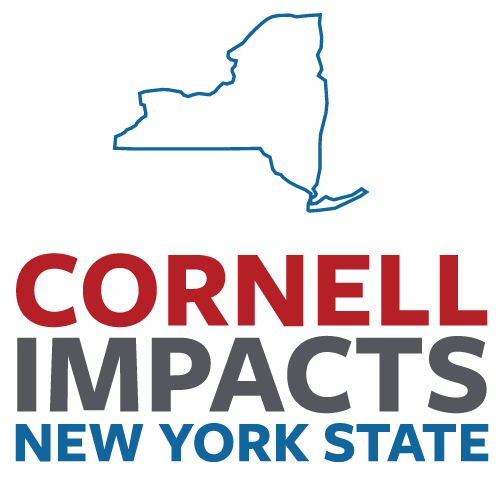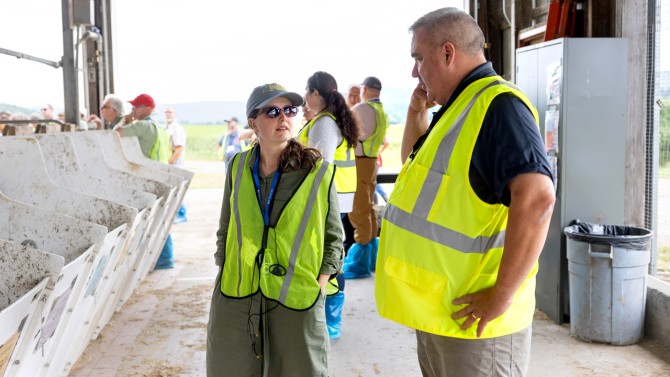
Julio Giordano, professor of animal science in the College of Agriculture and Life Sciences, shows dairy industry leaders a collar that can track cows' food intake, at the Cornell University Ruminant Center on June 30.
‘Farm of the Future’ showcased at Cornell PRO-DAIRY celebration
By Caitlin Hayes, Cornell Chronicle
Fifteen miles southeast of Cornell’s Ithaca campus, in a sprawling valley surrounded by wooded hills, a Cornell-operated, commercial-scale dairy farm resembles many across New York state. Adjacent to manure and feed storage, two large, red barns house 570 milking cows, all of it encircled by crop fields.
But look closely, and you can see that the Cornell University Ruminant Center (CURC) isn’t a standard dairy farm – that on top of the work of managing the farm, a vast number of questions are being asked and answered. Cameras and sensors are affixed to the barns’ rafters. Cows wear collars adorned with sensors. A long line of feeding bins are labeled with project numbers. There’s evidence that researchers are studying every piece of the dairy farm system, from cows’ diet and reproduction to manure management to growing the crops that feed the cows.
Cornell faculty, staff and industry partners say CURC, in the township of Harford, New York, is a one-of-a-kind testbed for new technologies and strategies that, since its construction in 2013, has been crucial to helping New York state dairy farmers improve processes, profits and environmental stewardship.
“Today shows me that integrated system that we have in New York state, starting first and foremost with Cornell,” said Katie Howard, deputy commissioner for the New York State Department of Agriculture and Markets, at a June 30 event showcasing CURC and the research and extension associated with it. “The relationship between the state and Cornell, and with industry, our processors, our producers, and the research that’s being done here – that’s really the envy of the country.”
The daylong event, which began with presentations at Hopshire Farm and Brewery and ended with a tour of CURC, was attended by more than 60 industry leaders and Cornell faculty and staff associated with CURC and PRO-DAIRY, an applied research and extension program in the College of Agriculture and Life Sciences (CALS) that has supported the New York state dairy industry since 1988. The aim was to update the community on recent advances and new projects, celebrate accomplishments and take stock of available resources and needs at a time of uncertainty in the future of federal and state funding. The meeting is part of a larger effort by PRO-DAIRY to make the myriad efforts of Cornell extension associates and researchers more tangible for stakeholders.
“It’s really to help illustrate to those who are involved the comprehensive nature of how we support the industry,” said Thomas Overton, director of PRO-DAIRY and professor of animal science (CALS). “We have PRO-DAIRY but also a variety of other research programs that feed into that. It’s an ecosystem where we’re all interacting and looking at innovation in all areas of farm management.”
New York state ranks fifth in milk production nationally, and the industry is poised to grow, with multiple processors recently announcing plans to build or expand operations in the state. Chobani, which already has a significant presence in New York, announced plans to build the largest dairy processing plant in the country in Rome, New York, a $1.2 billion investment; fairlife is building its first New York state plant in Webster, near Rochester, and other companies are moving to the state or expanding existing operations.
Howard, as well as Tonya Van Slyke, executive director of the Northeast Dairy Producers Association, said a big part of the attraction for these processors is the community of dairy farmers in the state and their success, which is bolstered and accelerated by the relationship they have with Cornell.
“I just can’t say enough about how much PRO-DAIRY and Cornell, the work they do – the research, the outreach, education, collaboration – helps farmers grow,” Van Slyke said. “Our relationship allows us to make sure that research is front and center, to make sure we have a scientific approach to continuous improvement.”
Envisioning the ‘farm of the future’
Researchers at CURC said they are building a foundation for the farm of the future, but what does that look like? In multiple demonstrations at CURC, researchers and extension staff painted a picture of a future in which farmers collect and harness more data for decision-making, with the ultimate goal of using that data to create an integrated, circular farm system where every piece – from feeding to manure management to crop production and back to feeding – is optimized for productivity, animal health and lower greenhouse gas emissions.
But as PRO-DAIRY Senior Extension Associate Jason Karszes said, in order to manage it, farmers first need to measure it.
With a $4.3 million grant from the U.S. Department of Agriculture, Julio Giordano, professor of animal science (CALS), has established the Cornell Agricultural Systems Testbed and Demonstration Site (CAST) for the Farm of the Future. CAST is using CURC to develop and test emerging, data-driven technologies and techniques that will help farmers gather the data they need to optimize and react to shifting conditions.
Examples include overhead cameras in the milking parlor that could allow farmers to more easily monitor animal health and mobility. Collars with built-in sensors could help farmers measure the food intake of individual cows and how that relates to output, and environmental monitoring could provide farmers with data about air quality and emissions – to name a few. The vision is to eventually create decision-making tools such as a farm dashboard that incorporates multiple data streams to give farmers a full picture of what’s happening on their farms.
“We’re trying to bring data-driven technologies as close as possible to application,” Giordano said. “And we are working in this feedback loop with what we know from farms, what we know is coming, what’s interesting, and we’re bringing them to our testbed first … some things will have a pretty substantial impact very quickly, and there are some things that will fail, but that’s the point – we are doing that testing so you don’t have to.”
Researchers are also testing: feeding changes that could increase productivity, reduce methane emissions and ensure cows’ health through the cycles of reproduction; new ways to store and treat manure to reduce emissions, improve its use as a fertilizer for crops, and even to generate power; and technologies and best practices for growing more resilient crops.
All of this research is connected to what’s happening on New York state farms and very often benefits from farmers sharing their data. The Nutrient Management Spear Program, run by Quirine Ketterings, professor of animal science (CALS), has recently devised strategies for using sensor technology to study crop yields and for measuring total farm nutrient cycling and greenhouse gas emissions. She has worked with farmers throughout the state to collect data they can then use to benchmark against themselves or others.
“Farmers across New York state have provided data back in terms of different soil types and overall yields from crops and the use of different management practices,” Van Slyke said. “We need CURC and that relationship with the farms around the state – it’s a circular relationship, and they’re very, very important to one another.”
That relationship has been built over decades through PRO-DAIRY’s direct extension work with farmers – bringing farmers together for groups and conferences around the challenges they face and providing needed analyses and impartial, data-driven advice.
Retired dairy farmer Meghan Hauser said she consulted with PRO-DAIRY staff on a weekly basis, for advice on feeding calves, barn construction or renovations, the best forages to use, how to protect the environment and how to keep employees safe.
PRO-DAIRY and the research at CURC is needed in multiple areas going forward, Hauser said, as New York state’s capacity for processing increases, including understanding climate change’s influence on food production and dairy’s role in greenhouse gas mitigation, as well as challenges in staffing and management.
“We need talented researchers to seek out and work on our next challenges,” she said. “A fully staffed, fully funded, fully equipped PRO-DAIRY team is vital to the future of New York state dairy … it’s our most powerful weapon for long-term success.”
Media Contact
Get Cornell news delivered right to your inbox.
Subscribe



